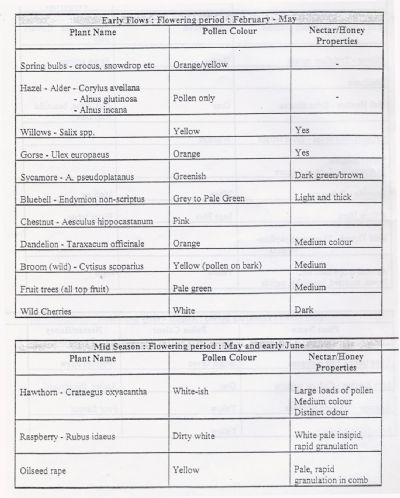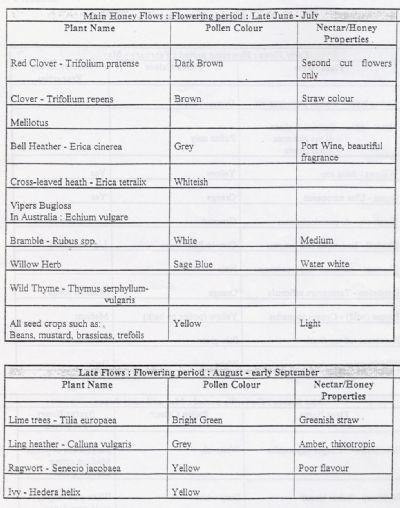Please access the sub-menu for a chart of pollen colours. A colour chart is available here and here.
There are three lists provided below. Clicking on the link will take you directly to the section. Return to the top of the page by clicking on "Bee Friendly Plants" in the top menu.
1. A description based on the seasonal flow of nectar.
2. Lists of wild plants in Easter Ross of value to the beekeeper.
3. Lists provided by the Scottish Agricultural College. SAC_Honey_sources
Early flows: Flowering period: February - May
Spring bulbs - crocus, snowdrop etc.
Hazel - Alder Corylus avellana
Alnus glutinosa
Alnus incana
Willow - Salix spp.
Gorse - Ulex europaeus
Sycamore - A.pseudoplatanus
Bluebell - Endymion non-scriptus
Chestnut - Aesculus hippocastanum
Dandelion Taraxacum officinale
Broom (wild) - Cytisus scoparius
Fruit trees (all top fruit)
Wild cherries
Mid season: Flowering period: May and early June
Hawthorn - Crataegu oxyacantha
Raspberry - Rubus idaeus
Oilseed rape
Main honey flows: Flowering period: Late June - July
Red Clover - Trifolium pratense
Clover - Trifolium repens
Melilotus
Bell heather - Erica cinerea
Cross-leaved heath - Erica tetralix
Vipers Bugloss
Bramble - Rubus spp.
Willow Herb
Wild Thyme - Thymus serphyllum-vulgaris
All seed crops such as: Beans, mustard, brassicas, trefoils
Late Flows: Flowering period: August - early September
Lime trees - Tilia europaea
Ling heather - Calluna vulgaris
Ragwort - Senecio jacobaea
Ivy - Hedera helix
WILD PLANTS IN EASTER ROSS
WHICH ARE OF VALUE TO THE BEEKEEPER
N = nectar; P = pollen; * good; ** very good.
Spring - Early Summer
Whin/gorse (N*P**), dry banks, field edges, extensive Feb-Apr
Willow, several species (N**,P**), woodland edge, by rivers lochans, extensive Apr-May
Dandelion (P**), grassland, road verges Apr-May
Bluebell/wild hyacinth (N**), woodland edge, clearings, dry sunny banks May
Blaeberry (N*), moorland, woodland edge (birch-pine) May
Sloe/blackthorn (N*), woodland edge, field edge Apr
Broom (P**), dry banks, field edges May-Jun
Rowan (P*,N ), woodland and edge May
Gean (P, N*), woodland and edge May
Early - Mid Summer
Raspberry (N**,P*), woodland edge and clearings; road verges Jun-Jul
Hawthorn (N*,P*), hedgerow, field edge May-Jun
Elder (P*), woodland edge, gardens Jun
Wild rose, several species (P*,N*), road verge, field edge, woodland edge May-Jul
Bishopweed (N P ), old garden and pasture, road verge May-Jul
Cow parsley (N P ), old garden and pasture, road verge
Thyme (N*), dry heathy banks, gravelly stream margins (Jun-Aug)
White clover (N**,P ), field, pasture, grass verges (Jun-Aug)
Meadowsweet (N P ), wet, ungrazed meadows, loch and stream margins (Jul-Aug)
Tufted vetch (N*), grassy banks, hedgerows Jun-Aug
Bird's-foot-trefoil, (N ,P*), short grassy turf Jun-Jul
Purple dead-nettle (N*), margins of cultivated ground Jun-Aug
Bramble (N**,P*), hedgerows, woodland edge Jun-Sep
Willowherb (N**,P*), woodland margin and clearings, field edge (Jul-Aug)
Marsh cinquefoil (N*), peaty loch margins, fens Jun-Jul
Thistles (creeping, spear, marsh)(N**,P*), road verges, damp pasture Jun-Aug
Bell heather (N**,P*), dry heath, rocky knolls Jun-Jul
Late Summer - Autumn
Ling heather (N**,P**), Dry moor, pinewood edge and clearings Aug-Sep
Ragwort (N**,P**), waste ground, old dry pasture, grass verges Aug-Oct
Ivy (N*), walls, trees Oct-Nov
While pollen or nectar may be collected from any of the above species in season, it is where they are available in quantity that surplus may be collected. Where local conditions provide this situation then almost any of the above species may provide a significant contribution.
In practice, however, only a small number of these species of wild plant indicated as good or very good on the table are significant contributors to surplus, the main ones being willows, whin/broom, raspberry, white clover, willowherb, heather and ragwort. In fact many of the main nectar sources are naturalised imported species rather than native species, the main ones being policy tree such as sycamore, horse chestnut and lime, which, along with garden and commercial crops such as oil seed rape, beans, fruit bushes (e.g. raspberry) and trees (e.g. apple) are major sources of supply for many local beekeepers.
Pollen chart in colour produced by Sheffield Beekeepers Association.
Pollen chart in colour produced by North Shropshire Beekeepers Association.
Jointly produced by Scottish Agricultural College and ATB-Landbase March 1997

